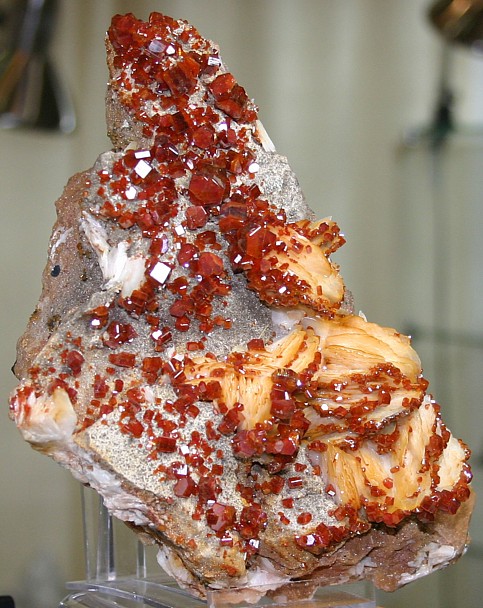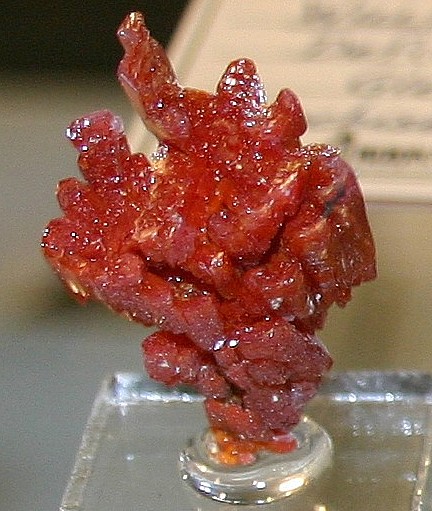|
.
Vanadinite Mineral Facts:
Chemical Formula: (Pb4(PbCl)(VO4))3
Phosphorus and arsenic are sometimes present in
small amount replacing vanadium. Mimeite is the arsenic end member, and
pyromorphite is the phosphorus end member.
Colors:
Color
ruby-red, brown, yellow.
Hardness:
3.0
Density: 6.9
to 7.1
Cleavage:
None
Crystallography: Hexagonal
Often the crystals have hollow faces. Frequently they are grouped into
pyramids like those of
pyromorphite. The mineral occurs also in globules and crusts.
Luster:.
Adamantine or resinous. Transparent to opaque.
Optics:
(Refractive Index) w=2.354, e=2.299
|
 |
|
.
Composition,
Structure and Associated Minerals:
Vanadinite
is a rare mineral of secondary origin found in the
upper oxidized portion of lead veins. It occurs in various districts in
Arizona, Nevada and New Mexico. Still, vanadinite
is the most widely distributed of all the vanadium minerals.
It usually occurs in small bright red prismatic crystals implanted
on other minerals, or on the walls of crevices in rocks. It is one of the
sources of the metal vanadium.
Identification and Diagnostics
In the closed tube vanadinite decrepitates. It fuses easily on charcoal
to a black lustrous mass which is reduced on being further heated in the
reducing flame to a globule of lead. A white sublimate of PbCl also coats
the charcoal. The mineral, moreover, gives -the flame test for chlorine with
copper. After complete oxidation of the lead by heating in the oxidizing
flame on charcoal the residue gives an emerald-green bead in the reducing
flame with microcosmic salt and this turns to a light yellow in the
oxidizing flame. The mineral is soluble in hydrochloric acid. If to the
solution a little hydrogen peroxide is added it will turn brown. The
addition of metallic tin to this will cause it to turn blue, green and
lavender in succession, in consequence of the reduction of the vanadium
compounds. Vanadinite is easily distinguished from most other minerals by
its color. It is distinguished from other compounds of the same color by its
crystallization and by the reactions for vanadium.
|
 |
|
|
Occurrence,
Localities and Origins:
Vanadinite is a
source of vanadium and minor ore of lead. Vanadium is obtained chiefly from
other ores, such as the sulphide, patronite;
the uranium vanadate, carnotite; and a vanadium mica, roscoelite. Vanadium
is used chiefly as a steel hardening metal. Metavanadic acid, HV03 , is used
as a yellow pigment, known as vanadium bronze. Vanadium oxide is used as a
mordant in dyeing. Well developed
crystals make showy mineral specimens and are
highly desired by collectors.
Vanadinite occurs principally
in regions of volcanic rocks. It is the result of secondary
concentration processes working on primary ore bodies. Crystals are
found at Zimapan, Mexico; Wanlockhead, England; Undenas, Sweden; .in the
Sierra de Cordoba, Argentine, and in
the mining districts of Arizona and New Mexico. Vanadinite is an
important source of vanadium, which is employed in the manufacture of
certain grades of steel and bronze. Its compounds are, moreover, used as
pigments and mordants. Whileit is an important mineral, most of the
vanadium compounds produced in this country are obtained from other
vanadium minerals, among them patronite a mixture, of which
the principal component is a sulphide and
carnotite. Vanadinite has been used to produce vanadium abroad and
also to a small extent in the
United States.
Return to the
Mineral Collectors Information Page |


